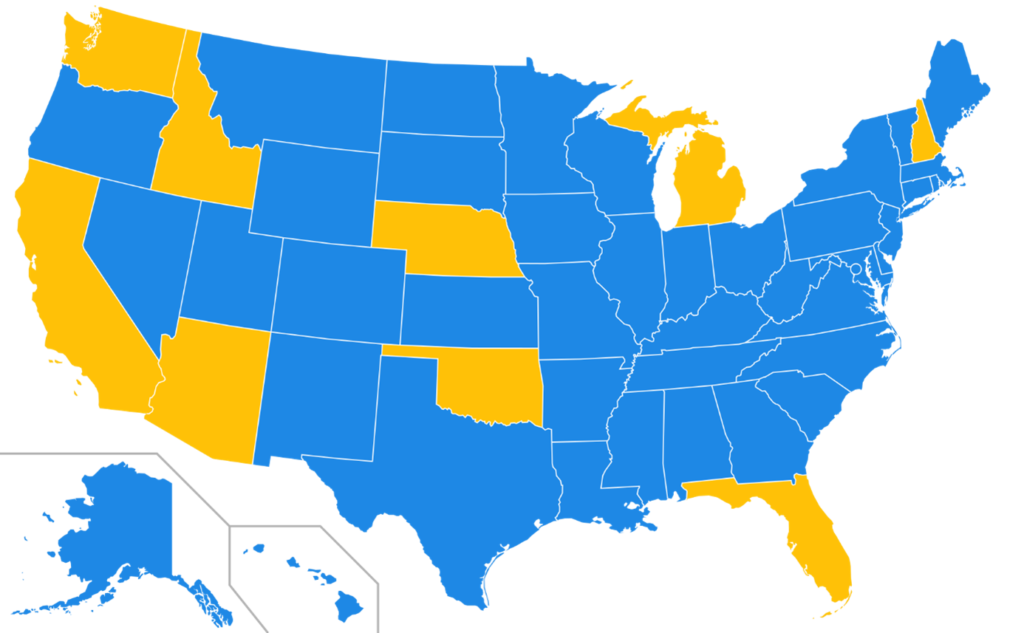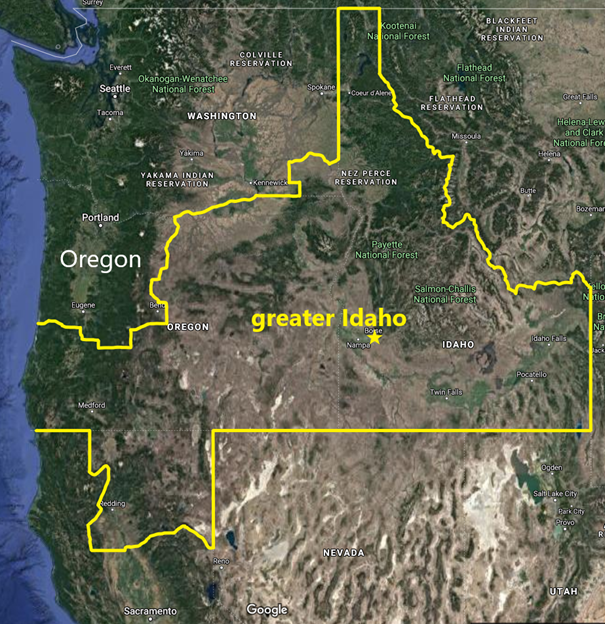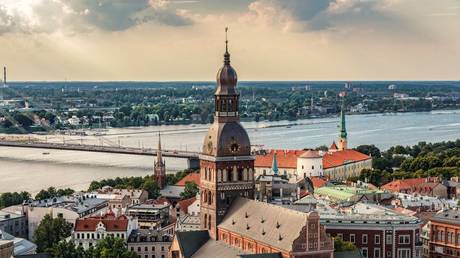Greater Idaho: A Vision for a Red Super-State
The following is reprinted from the Homeland Institute (website, Telegram).
The Greater Idaho movement promises many benefits, and particularly to white Americans. In this article we will explore what the State of Greater Idaho would bring to its new residents, and what challenges this project faces.
Greater Idaho’s Conception
The official website of the Greater Idaho movement states: “In 2019, supporters of joining Idaho who live in eastern Oregon interacted online with State of Jefferson proponents in southern Oregon.” The State of Jefferson is a movement which has long sought to extricate the counties of northern California and southern Oregon, which are overwhelmingly white and conservative in character, from their current states and to form a new state by the name of Jefferson.
From these interactions between the supporters of the State of Jefferson and the Greater Idaho movement sprung the “Move Oregon’s Border” initiative. This initiative was founded by Mike McCarter, who is today the current President of the Greater Idaho movement. This humble beginning from online chatrooms, predominantly on platforms such as Facebook, quickly snowballed into action. Mike McCarter and his supporters took to e-mailing their county clerks, seeking to place advisory questions about moving the border on local ballots. A successful move in February and June of 2020 has led to the votes held thus far.
The Potential of Greater Idaho
Thus far 11 of the 17 counties of Oregon which the Great Idaho movement seeks to incorporate have voted in favor of joining Idaho. A 12th county is set to vote in the near future, and five counties have yet to decide on holding such a vote. Significantly, not a single county has yet voted against joining Idaho, and all of those which have are in a contiguous formation.
This is a remarkable development considering that the movement only came into being in early 2020. This rapid progress shows the solid thinking of the movement’s founders, much of which is tailored to justifying the idea to the liberals who might otherwise oppose it.
A Greater Idaho seeks to soothe liberal fears of a more conservative United States government, because unlike the creation of a new state, the Greater Idaho plan does not add two new senators to the US Congress, thereby not undermining Democratic power in that institution. Furthermore, it would be an entire decade before Greater Idaho would receive additional members in the House of Representatives, as reapportionment only occurs every ten years, after the census results are released. Greater Idaho is about the immediate needs of the population in eastern Oregon, not about attempting to wrest federal control from the increasingly dogmatic establishment class which currently has this power.
The power of the federal government is often the primary feature of discussion in American politics, but the reality remains that the vast majority of services provided to Americans remains the purview of state governments. Americans also interact with their state government more than any other level, local or federal, as they seek out work benefits, Supplemental Nutrition Assistance Program (SNAP) food assistance, a new driver’s license, and a myriad of other documentation, licensing, and benefits to go about their lives.
A fantastic example of the way in which states can offer meaningful policy choices even in the modern age of federal overreach is in the area of affirmative action, one of the most controversial and anti-white policies ever devised. Idaho is one of nine states, pictured above in yellow, which has laws against affirmative action in workplaces and by government. Oregon, as indicated by the blue coloring, does allow affirmative action, and in fact to a rather significant degree. The whites of eastern Oregon would find relief from such a policy should they join Idaho.
Residents of Greater Idaho could also expect much higher investment in the future of their children, by nature of a more conservative and demographically cohesive environment. Idaho invests nearly $10,000 per student per annum, while Oregon invests only $6,000 per student per annum. Idaho generally ranks several points above Oregon in the quality of its schools. Tertiary educational opportunities also abound, with in-state tuition for students in Idaho costing an average of $16,300, which is $7,300 cheaper than in Oregon.

You can buy Greg Hood’s Waking Up From the American Dream here.
Another way in which a Greater Idaho would appeal to the political views of eastern Oregon’s population is on social issues. Idaho bans abortion entirely, while abortion in Oregon up to the point of birth is legal. Idaho also bans same-sex marriage, though of course this cannot be enforced due to a Supreme Court ruling. Oregon also officially possesses a same-sex marriage ban, though it is doubtful this policy would survive judicial review.
There are also policy benefits for the substantial Democratic voter base in northwest Oregon, where 79% of the state’s population resides. These liberal-minded urban voters would no longer be responsible for the large tax transfers which occur between the various regions of the state as is currently constituted. Furthermore, the long-fought battles over county autonomy, the minimum wage, and spending on infrastructure projects (such as public transit in the dense urban heart of the state) would finally come to an end as the nearly completely blue rump of Oregon would cease to face substantial opposition from a conservatively-minded hinterland.
There remains a collection of other policy differences which would require a lengthier analysis to fully explore, but which are no less important to the average white American seeking to raise a family in safety. The tax burden in Idaho is significantly lower than in Oregon, there is much less crime, and Idaho ranks among the top ten in the nation for the protection of Second Amendment rights, while Oregon ranks in the middle of the pack in the most generous of surveys.
Holding Back a Greater Idaho
While we have outlined the relatively simple process for changing the state borders, which requires the consent of all involved state legislatures and the approval of Congress, it remains to be seen whether popular will can overcome the liberal desire for utopianism and the establishment desire to dominate the lives of all citizens. The Governor of Idaho has come out in favor of the Greater Idaho movement, even going on FOX News to affirm his support. The government of Oregon has said remarkably little as regards this movement, though Republican representatives of the areas which wish to join a Greater Idaho have introduced a bill to the state legislature which would begin the process.
While the Greater Idaho movement has tried to prove it has no immediate desire to threaten the Democrats’ control of the federal government, this is likely not going to be enough. As displayed during the COVID-19 pandemic and aftermath of the 2020 election, the establishment ruling class seeks to impose its policies and views on the entire population. Oftentimes, it would seem as though the establishment relishes opportunities to punish conservatives for various types of wrongthink and ideological transgressions.
It also remains to be seen if a Democrat-controlled US Senate would consent to the exchange of territory between Idaho and Oregon, as Democratic senators from other states such as California, Washington state, Colorado, and Virginia may worry about the precedent which this sets. After all, if Oregon and Idaho can change borders, then what democratic principle could possibly be employed to prevent the integration of white and or conservative areas from other blue states into neighboring red ones? It is worth noting that if redrawing the border is successful in the currently-targeted 17 counties, the movement plans to expand its scope, and will seek to incorporate coastal southern Oregon and the areas of California which would form the State of Jefferson.
With this being the case, control of both houses of Congress will be crucial to forwarding the Greater Idaho movement. Republicans could incentivize blue Oregon with federal dollars for various Democrat programs the state is currently unable to fund, along with various other concessions.
Perhaps the most remarkable implication of this entire saga is the evolution which it represents. States have steadily become more politically entrenched. Voters in red states become ever more conservative, while voters in blue states become ever more convinced of the superiority of their ideas. More and more states have trifecta governments in which a single party controls every branch of government. Currently, only 11 states — Alaska, Arizona, Kentucky, Louisiana, Kansas, North Carolina, Nevada Pennsylvania, Vermont, Virginia, and Wisconsin — do not have a state government dominated by a singular party. Republicans dominate 22 state governments, and Democrats the remaining 17.
It is a natural outcome that conservative voters in blue states who do not have not a single voice in their state government would want to seek a more representative polity in which to reside. It is also possible that this might expand to Democrats trapped in deeply red states, such as those largely black areas in northern Indiana or the blue areas of North Carolina which border Virginia, again largely composed of a black voter base.
In order to change the boundaries of states the legislatures of all of the relevant states must approve, and then the entire plan must be approved by both houses of Congress. Compared to most other changes, such as adding an amendment to the Constitution, this is a relatively simple process. But the likelihood of such a change in borders happening, even if backed by overwhelming popular support, remains an open question.
* * *
Like all journals of dissident ideas, Counter-Currents depends on the support of readers like you. Help us compete with the censors of the Left and the violent accelerationists of the Right with a donation today. (The easiest way to help is with an e-check donation. All you need is your checkbook.)
For other ways to donate, click here.







